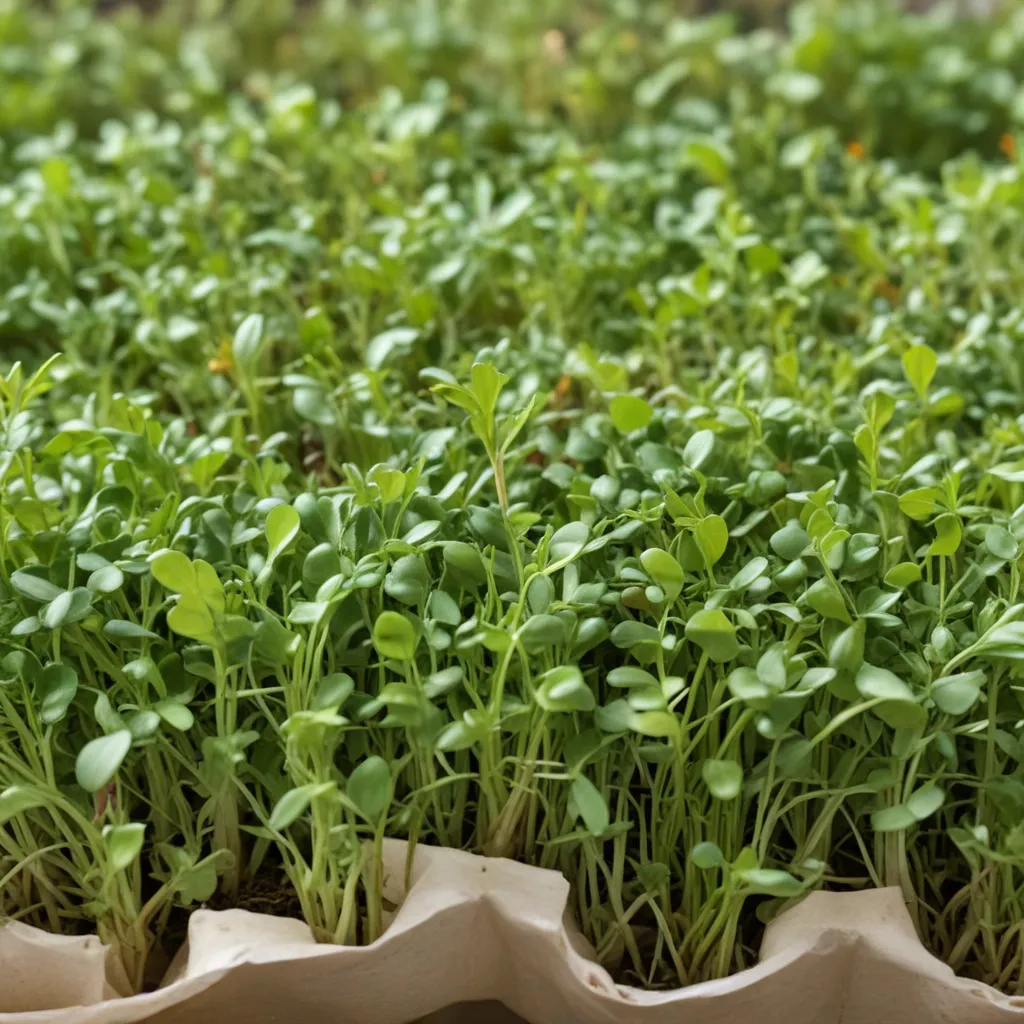
Microgreens are the latest nutrition powerhouse to emerge from the farm-to-table movement, boasting impressive nutrient densities up to 40 times higher than their mature counterparts. These tiny, vibrant seedlings pack a punch of flavor and health benefits, making them a versatile addition to any meal. At Crooked Pines Farm, we’re excited to share our expertise on mastering the art of microgreens cultivation, so you can enjoy these nutrient-rich delights year-round, no matter the season.
The Benefits of Microgreens
Imagine being able to grow your own fresh, flavorful greens in the comfort of your home, even during the chilliest winter months. Microgreens offer precisely that opportunity, and the nutritional payoff is remarkable. A 2012 study found that microgreen versions of popular vegetables like broccoli, kale, and red cabbage can contain up to 40 times more vital nutrients than their fully-grown forms.
This nutrient density stems from the plants’ juvenile vigor, a phenomenon where young seedlings channel their energy into rapidly producing concentrated vitamins, minerals, and antioxidants to aid in their survival. Broccoli microgreens, for example, boast dramatically higher levels of the cancer-fighting compound sulforaphane compared to mature broccoli.
Beyond their nutritional prowess, microgreens also deliver exceptional flavor and texture. The intense, vibrant tastes of herbs like basil and cilantro, or the peppery kick of arugula, are beautifully concentrated in their microgreen forms. The tender, crunchy mouthfeel of these miniature greens makes them a delight to incorporate into salads, sandwiches, soups, and more.
Microgreens also offer remarkable versatility. Whether you follow a vegan, vegetarian, paleo, or keto diet, these nutrient-dense gems can easily be incorporated into your meals. They seamlessly complement a wide range of dishes, from breakfast smoothies to gourmet entrees. With their small footprint and quick cultivation, microgreens are an accessible way to boost the nutritional value and visual appeal of your culinary creations.
Choosing the Right Microgreen Varieties
While microgreens may seem limited to a few familiar crops like broccoli and kale, the options are actually quite diverse. At Crooked Pines Farm, we grow a wide array of microgreen varieties, each with its own unique flavor profile and cultivation requirements.
Some of our favorite microgreens to cultivate include:
- Basil: Offering a fragrant, sweet flavor
- Cilantro: A perfect complement to Mexican and Asian-inspired dishes
- Kale: Delivering a robust, earthy taste
- Arugula: Providing a peppery punch
- Radish: Exhibiting a crisp, spicy snap
When selecting your microgreen seeds, be sure to choose high-quality, organic options. This ensures you’re getting the most nutritious and flavorful crop possible. Many reputable seed companies, like High Mowing Organic Seeds and Johnny’s Selected Seeds, offer specialized microgreen seed mixes and growing guides to help you get started.
It’s also important to consider the microgreens’ growing conditions and timeline. Some varieties, like pea shoots and broccoli, mature more quickly (10-15 days) compared to others, like basil and cilantro (15-25 days). Mixing and matching compatible crops in the same tray can help you maximize your harvest and maintain a continuous supply.
Cultivating Microgreens Indoors
One of the best things about growing microgreens is that it can be done right in your own home, no matter the weather outside. All you need is a well-lit area, some basic equipment, and a green thumb (or two!).
To set up your indoor microgreen oasis, you’ll need:
- Grow Lights: LED or fluorescent lights that provide 16 hours of illumination per day
- Planting Trays: Shallow trays with drainage holes for bottom-watering
- Potting Soil: A high-quality, nutrient-rich potting mix or soilless growing medium
- Watering Equipment: A spray bottle or self-watering tray setup
- Harvest Tools: Sharp scissors or a microgreen harvesting knife
Begin by filling your planting trays with 1-inch of your chosen growing medium. Sprinkle the microgreen seeds densely across the surface, aiming for 10-12 seeds per square inch. Lightly cover the seeds with a thin layer of vermiculite or potting soil to help retain moisture.
Keep the soil consistently moist by misting the surface or using a bottom-watering technique. Once the seeds have germinated, which typically takes 3-5 days, remove any humidity domes or covers and place the trays under your grow lights.
Optimizing Growth and Harvest
Proper lighting, temperature, and watering are key to cultivating thriving microgreens. Aim for a consistent growing environment between 65-70°F, and provide 16 hours of full-spectrum light per day to ensure robust growth.
When it comes to watering, be gentle. Microgreens are delicate, and heavy overhead watering can damage or flatten the tender seedlings. Instead, use a spray bottle or self-watering tray setup to keep the soil consistently moist but not saturated.
Microgreens are typically ready to harvest 10-25 days after sowing, depending on the variety. Use sharp scissors or a microgreen harvesting knife to snip the stems just above the soil line, leaving the delicate root systems intact. This allows you to enjoy multiple harvests from a single tray.
After harvesting, thoroughly clean and disinfect your trays to prevent the buildup of mold or pathogens that could impact future crops. With a bit of practice, you’ll quickly get the hang of maintaining a steady supply of these nutrient-packed powerhouses.
Whether you’re seeking to boost the nutritional value of your meals, explore new and diverse flavors, or simply reconnect with the joys of growing your own food, microgreens offer an incredible opportunity. At Crooked Pines Farm, we’re passionate about sharing our knowledge and helping families master the art of cultivating these remarkable edibles. So why not give it a try and unlock the hidden potential of your indoor growing space?


